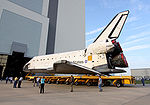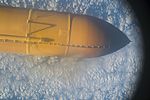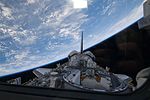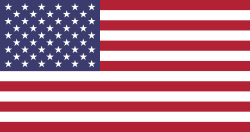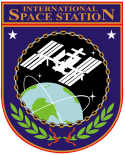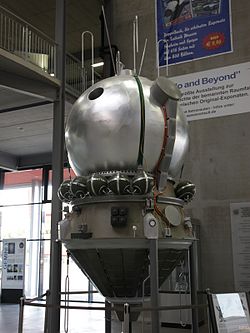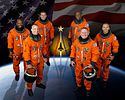STS-129
| STS-129 | |||||
 | |||||
| Uppdrag | ? | ||||
|---|---|---|---|---|---|
| Rymdfärja | Atlantis (31) | ||||
| NSSDC-ID | 2009-062A[1] | ||||
| Färdens tid | 10 dagar, 19 timmar, 16 minuter, 55 sekunder | ||||
| Uppskjutning | |||||
| Startplats | Startplatta 39A vid Kennedy Space Center i Florida | ||||
| Start | 16 november 2009 kl. 20.28 svensk tid. | ||||
| Landning | |||||
| Landningsplats | KSC runway 33 | ||||
| Landning | 27 november 2009 kl. 15.44 svensk tid. | ||||
| Omloppsbana | |||||
| Varv | 171 st[2] | ||||
| Apogeum | 233 km | ||||
| Perigeum | 156 km | ||||
| Banlutning | 51,6° | ||||
| Sträcka | 7,1 miljoner km | ||||
| Rymdpromenad | |||||
| Antal | 3 st | ||||
| Total tid | 18 timmar, 27 minuter | ||||
| Dockning | |||||
| Rymdstation | ISS | ||||
| Dockning | 18 november 2009, 16:51 UTC | ||||
| Dockningsport | PMA-2 (Harmony, fram) | ||||
| Urdockning | 25 november 2009, 09:53 UTC | ||||
| Tid dockad | 6 dagar, 17 timmar, 2 minuter | ||||
| Besättning | |||||
| Befälhavare | Charles O. Hobaugh (3) | ||||
| Pilot | Barry E. Wilmore (1) | ||||
| Uppdragsspecialister | Michael Foreman (2) Randolph Bresnik (1) Leland D. Melvin (2) Robert Satcher (1) | ||||
 | |||||
| Kronologi Rymdfärjeprogrammet | |||||
| |||||
STS-129 var en flygning i USA:s rymdfärjeprogram till Internationella rymdstationen ISS som genomfördes med rymdfärjan Atlantis. Starten skedde den 16 november 2009 kl 20.28 svensk tid. Uppdraget var Atlantis första flygning till ISS på nästan två år. Uppdraget var ett rent fraktuppdrag då gyroskop, kvävetankar och andra reservdelar flögs till rymdstationen. Landningen skedde på Kennedy Space Center bana 33 den 27 november kl. 15.44 svensk tid. Därmed avslutades detta uppdrag och Atlantis 31:a flygning till rymden.
Aktiviteter
Innan uppskjutning
Den 6 oktober rullade Atlantis från sin hangar till Vehicle Assembly Building där hon monterades på sin externa bränsletank. Hon rullade sedan ut till startplatta 39A den 14 oktober.
Aktiviteter dag för dag

Dag 1: Atlantis lyfte enligt planerna kl. 20.28 svensk tid från Kennedy Space Center. Den 8 minuter långa färden till rymden gick utan problem. Besättningen öppnade färjans lastrumsdörrar samt stuvade undan stolar och startmaterial.
Dag 2: Besättningen undersökte Atlantis värmesköldar med hjälp av robotarmen. De kontrollerade även rymdpromenadsutrustningen för att verifiera att den inte skadats under starten, samt förberedelser inför dockningen med ISS
Dag 3: Atlantis dockade med ISS kl. 17.53 svensk tid. När Atlantis befann sig under ISS gjorde befälhavare Charlie Houbaugh en bakåtvolt så besättningen på ISS kunde ta bilder av färjans värmesköldar. Efter att läcktester genomförts öppnades luckorna mellan farkosterna och välkomstfirandet kunde börja. Nicole Stott överfördes till besättningen på STS-129 efter ha varit medlem av ISS-besättningen sedan augusti. Besättningen förberedde för EVA 1.
Dag 4: Den första rymdpromenaden utfördes utan några problem. Överföringar mellan farkosterna stod även på dagens schema.
Dag 5: Besättningen deltog i flera mediahändelser under dagen. Atlantis värmesköldar godkändes för landning. Förberedelser inför EVA 2 stod även på schemat för dagen.
Dag 6: Den andra rymdpromenaden utfördes utan några problem. Under tiden jobbade en annan del av besättningen med överföringar mellan farkosterna.
Dag 7: Delar av besättningen deltog i en del mediahändelser med amerikanska radio- och tv-program. Besättningen förberedde även för EVA 3.
Dag 8: Den tredje och sista rymdpromenaden utfördes utan några problem. De sista överföringsarbetena mellan farkosterna gjordes. Besättningarna fick även bevittna ett befälsbyte på ISS.
Dag 9: Sista dagen på ISS för Atlantis besättning. Dagen bestod av att frakta över det sista från färjan till ISS och det som skulle med tillbaka till jorden från ISS. Sedan följde den sedvanliga avskedsceremonin och besättningen förberedde för utdockning som ägde rum under flygdag 10.
Dag 10: Atlantis dockade ut från ISS klockan 10.54 svensk tid efter att besättningarna kontrollerat att inga läckor fanns mellan farkosterna. Piloten Barry Wilmore flög färjan under utdockningen och avslutade sin flygning med en tur över ISS så resten av besättningen kunde ta fotografier på rymdstationen med jorden som bakgrund. En sista undersökning av Atlantis värmesköld företogs för att verifiera att inga skador uppkommit under tiden hon varit dockad med ISS.
Dag 11: Besättningen började förbereda för landning. Flygstolarna på mellandäcket monterades upp igen för landning efter ha legat undanstoppad sedan starten.
Dag 12: Atlantis landade på första försöket kl. 15.44 svensk tid på Kennedy Space Centers bana 33. Nicole Stott är därmed hemma efter cirka 90 dagar i rymden. Atlantis avslutade sitt 31:a uppdrag till rymden.
Rymdpromenader
EVA 1: Rymdpromenaden utfördes av Foreman och Satcher. En fästanordning för en S-bandantenn monterades. Reservkablar till en annan antenn och en fästanordning för en ammoniaktank monterades också under promenaden. Visst kablage drogs om och astronauterna felsökte en panel på fackelsegmentet S0. Anledningen till felsökningen på fackelsegmentet är en misslyckad kontaktinkoppling under STS-128.
EVA 2: Rymdpromenaden utfördes av Foreman och Bresnik. Under den andra rymdpromenaden installerades GATOR på Columbusmodulen. Detta för att prova om GATOR med automatik kan identifiera inkommande rymdfarkoster. Systemet bestod av två antenner och kablar. Ett mätinstrument på en av solpanelerna flyttades från fackelsegment S1 till P1. En lastplattform monterades på fackelsegment S3.
EVA 3: Rymdpromenaden utfördes av Satcher och Bresnik. Under den tredje rymdpromenaden monterades en högtryckstank på utsidan av den amerikanska luftslussen Quest. Tanken skulle användas för att tömma och fylla luftslussen med luft. De monterade även experimentplattformen MISSE 7 som skulle användas för utvändiga experiment. Till sist monterades den andra lastplattformen på fackelsegmentet S3.
Besättning
 USA Charles O. Hobaugh befälhavare. Tidigare rymdfärder STS-104, STS-118
USA Charles O. Hobaugh befälhavare. Tidigare rymdfärder STS-104, STS-118 USA Barry E. Wilmore pilot. Inga tidigare rymdfärder
USA Barry E. Wilmore pilot. Inga tidigare rymdfärder USA Michael Foreman uppdragsspecialist. Tidigare rymdfärd STS-123
USA Michael Foreman uppdragsspecialist. Tidigare rymdfärd STS-123 USA Randolph Bresnik uppdragsspecialist. Inga tidigare rymdfärder.
USA Randolph Bresnik uppdragsspecialist. Inga tidigare rymdfärder. USA Leland D. Melvin uppdragsspecialist. Tidigare rymdfärd STS-122
USA Leland D. Melvin uppdragsspecialist. Tidigare rymdfärd STS-122 USA Robert Satcher uppdragsspecialist. Inga tidigare rymdfärder.
USA Robert Satcher uppdragsspecialist. Inga tidigare rymdfärder.
ISS-besättning som bytes under detta uppdrag
 USA Nicole P. Stott reser med Atlantis tillbaka till jorden efter sin första rymdresa som medlem av Expedition 20 och Expedition 21 på ISS.
USA Nicole P. Stott reser med Atlantis tillbaka till jorden efter sin första rymdresa som medlem av Expedition 20 och Expedition 21 på ISS.
Väckningar
Under Geminiprogrammet började NASA spela musik för besättningar och sedan Apollo 15 har man varje "morgon" väckt besättningen med ett särskilt musikstycke, särskilt utvalt antingen för en enskild astronaut eller för de förhållanden som råder.
| Dag | Låt | Artist/Kompositör | Spelad för | Länk |
|---|---|---|---|---|
| 2 | “I Can Only Imagine” | MercyMe | Barry E. Wilmore | wav mp3 |
| 3 | “Higher Ground” | Stevie Wonder | Robert Satcher | wav mp3 |
| 4 | “In Wonder” | Newsboys | Randolph Bresnik | wav mp3 |
| 5 | “We Are Family” | Sister Sledge | Leland D. Melvin | wav mp3 |
| 6 | “Voyage to Atlantis” | The Isley Brothers | Robert Satcher | wav mp3 |
| 7 | “Butterfly Kisses” | Bob Carlisle | Randolph Bresnik, som blivit pappa några timmar tidigare | wav mp3 |
| 8 | “Space Rise” | Larry Whitehair | Michael Foreman | wav mp3 |
| 9 | “The Marine Corps Hymn” | The Marine Corps Band | Charles O. Hobaugh | wav mp3 |
| 10 | “Amazing Grace” från Braveheart | Eric Rigler | Barry E. Wilmore | wav mp3 |
| 11 | “Fly Me to the Moon” | Frank Sinatra | Nicole P. Stott | wav mp3 |
| 12 | “Home Sweet Home” | Mötley Crüe | hela besättningen | wav mp3 |
Galleri
- Atlantis rullar över från sin hangar till VAB.
- Atlantis på startplattan innan start.
- Atlantis startar från Kennedy Space Center.
- Bild efter tanken släppts.
- Vy över jorden och Atlantis lastutrymme.
- Atlantis närmar sig ISS.
- Mike Foreman ute på en rymdpromenad.
- Atlantis och ISS besättning tillsammans.
- Atlantis sedd från ISS efter utdockningen.
- Atlantis landar Kennedy Space Center.
Se även
Referenser
- ^ ”NASA Space Science Data Coordinated Archive” (på engelska). NASA. https://nssdc.gsfc.nasa.gov/nmc/spacecraft/display.action?id=2009-062A. Läst 22 mars 2020.
- ^ Manned Astronautics - Figures & Facts Arkiverad 4 mars 2016 hämtat från the Wayback Machine., läst 28 juli 2016.
Externa länkar
 Wikimedia Commons har media som rör STS-129.
Wikimedia Commons har media som rör STS-129.- Svensk sida om STS-129
| ||||||||
| |||||||||||||||||||||||||||||||
| ||||||||||||||||||||||||||||||||
Media som används på denna webbplats
Rotated and color enhanced version of original (ISS013-E-48788 (6 July 2006) --- The Space Shuttle Discovery approaches the International Space Station for docking but before the link-up occurred, the orbiter went through a series of inspection photos by station crew to inspect the vehicle for any damage to its Thermal Protection System. This was known as the Rendezvous Pitch Maneuver and was implemented after the Columbia Disaster in 2003. The Leonardo Multipurpose Logistics Module can be seen in the shuttle's cargo bay. Discovery docked at the station's Pressurized Mating Adapter 2 at 9:52 a.m. CDT, July 6, 2006.)
Backdropped by a blue and white Earth, this close-up view features the Soyuz TMA-6 spacecraft approaching the International Space Station (ISS). Onboard the spacecraft are cosmonaut Sergei K. Krikalev, Expedition 11 commander representing Russia's Federal Space Agency; astronaut John L. Phillips, NASA ISS science officer and flight engineer; and European Space Agency (ESA) astronaut Roberto Vittori of Italy. The Soyuz linked to the Pirs Docking Compartment at 9:20 p.m. (CDT) on April 16, 2005 as the two spacecraft flew over eastern Asia. The docking followed Friday’s launch from the Baikonur Cosmodrome in Kazakhstan.
In this illustration, a SpaceX Crew Dragon spacecraft approaches the International Space Station for docking. NASA is partnering with Boeing and SpaceX to build a new generation of human-rated spacecraft capable of taking astronauts to the station and expanding research opportunities in orbit. SpaceX's upcoming Demo-1 flight test is part of NASA’s Commercial Crew Transportation Capability contract with the goal of returning human spaceflight launch capabilities to the United States.
Författare/Upphovsman: Pascal (Flickr user: pasukaru76), Licens: CC0
Vostok spacecraft replica at the Technik Museum Speyer, Germany.
Backdropped by a blue and white part of Earth, Space Shuttle Atlantis is featured in this image photographed by an Expedition 21 crew member as the shuttle approaches the International Space Station during STS-129 rendezvous and docking operations. Docking occurred at 10:51 a.m. (CST) on Nov. 18, 2009. A Russian spacecraft docked to the station is at left.
CAPE CANAVERAL, Fla. – At NASA’s Kennedy Space Center in Florida, space shuttle Atlantis approaches the north door of the transfer aisle of the Vehicle Assembly Building. The rollover from its hangar, Orbiter Processing Facility 1, began about 7 a.m. EDT and was complete at 8:25 a.m. when Atlantis was towed into the VAB's transfer aisle. Next, Atlantis will be lifted over a transom and lowered into the VAB's high bay 1, where it will be attached to its external fuel tank and solid rocket boosters. Rollout of the shuttle stack to Kennedy’s Launch Pad 39A, a significant milestone in launch processing activities, is planned for Oct. 13. Liftoff of Atlantis on its STS-129 mission to the International Space Station is targeted for 4:04 p.m. EST during a 10-minute launch window on Nov. 12. For information on the STS-129 mission and crew, visit http://www.nasa.gov/mission_pages/shuttle/shuttlemissions/sts129/index.html.
Attired in training versions of their shuttle launch and entry suits, these six astronauts take a break from training to pose for the STS-129 crew portrait. Pictured on the front row are astronauts Charlie Hobaugh (left), commander; and Barry Wilmore, pilot. From the left (back row) are astronauts Leland Melvin, Mike Foreman, Robert Satcher and Randy Bresnik, all mission specialists.
One of the last occasions for these twelve Internationally-represented astronauts and cosmonauts to spend time together in space was topped off with a series of group portraits aboard the International Space Station. The group includes the seven STS-129 Atlantis astronauts Charles O. Hobaugh, commander; Barry E. Wilmore, pilot; and Nicole Stott, Mike Foreman, Leland Melvin, Robert L. Satcher Jr. and Randy Bresnik, all mission specialists, plus the five ISS crewmembers, Jeffrey Williams, the European Space Agency's Frank De Winne, the Canadian Space agency's Robert Thirsk and Russia's Federal Space Agency cosmonauts Roman Romanenko and Maksim Suraev. The dozen are wrapping up over a week sharing duties, tasks and chores aimed toward complete development of the orbital outpost.
Backdropped by Earth's horizon and the blackness of space, a partial view of Space Shuttle Atlantis' payload bay, vertical stabilizer, orbital maneuvering system (OMS) pods and docking mechanism are featured in this image photographed by an STS-129 crew member from an aft flight deck window.
CAPE CANAVERAL, Fla. - Space shuttle Atlantis kicks up dust as it touches down on Runway 33 at the Shuttle Landing Facility at NASA's Kennedy Space Center in Florida after 11 days in space, completing the 4.5-million mile STS-129 mission on orbit 171. Main gear touchdown was at 9:44:23 a.m. EDT. Nose gear touchdown was at 9:44:36 a.m., and wheels stop was at 9:45:05 a.m. Aboard Atlantis are Commander Charles O. Hobaugh; Pilot Barry E. Wilmore; Mission Specialists Leland Melvin, Randy Bresnik, Mike Foreman and Robert L. Satcher Jr.; and Expedition 20 and 21 Flight Engineer Nicole Stott who spent 87 days aboard the International Space Station. STS-129 is the final space shuttle Expedition crew rotation flight on the manifest. On STS-129, the crew delivered 14 tons of cargo to the orbiting laboratory, including two ExPRESS Logistics Carriers containing spare parts to sustain station operations after the shuttles are retired next year. For information on the STS-129 mission and crew, visit http://www.nasa.gov/mission_pages/shuttle/shuttlemissions/sts129/index.html.
Backdropped by a blanket of clouds, the external fuel tank (ET) is featured in this image photographed by the umbilical well camera aboard the Space Shuttle Atlantis shortly after separating from the shuttle following launch.
CAPE CANAVERAL, Fla. - Like a phoenix rising from the flames, space shuttle Atlantis takes flight from Launch Pad 39A at NASA's Kennedy Space Center in Florida. Liftoff on its STS-129 mission came at 2:28 p.m. EST Nov. 16. Aboard are crew members Commander Charles O. Hobaugh; Pilot Barry E. Wilmore; and Mission Specialists Leland Melvin, Randy Bresnik, Mike Foreman and Robert L. Satcher Jr. On STS-129, the crew will deliver two Express Logistics Carriers to the International Space Station, the largest of the shuttle's cargo carriers, containing 15 spare pieces of equipment including two gyroscopes, two nitrogen tank assemblies, two pump modules, an ammonia tank assembly and a spare latching end effector for the station's robotic arm. Atlantis will return to Earth a station crew member, Nicole Stott, who has spent more than two months aboard the orbiting laboratory. STS-129 is slated to be the final space shuttle Expedition crew rotation flight. For information on the STS-129 mission and crew, visit http://www.nasa.gov/mission_pages/shuttle/shuttlemissions/sts129/index.html.
The STS-128 patch symbolizes the 17A mission and represents the hardware, people and partner nations that contribute to the flight. The Space Shuttle Discovery is shown in the orbit configuration with the Multi Purpose Logistics Module (MPLM) Leonardo in the payload bay. Earth and the International Space Station wrap around the Astronaut Office symbol reminding us of the continuous human presence in space. The names of the STS-128 crew members border the patch in an unfurled manner. Included in the names is the expedition crew member who will launch on STS-128 and remain on board ISS, replacing another Expedition crew member who will return home with STS-128. The banner also completes the Astronaut Office symbol and contains the U.S. and Swedish flags representing the countries of the STS-128 crew.
For STS-129 the sun shines brightly on the International Space Station (ISS) above and the United States below representing the bright future of U.S. human spaceflight. The contiguous U.S., Rocky Mountains, and Great Desert Southwest are clearly visible on the earth below encompassing all the NASA centers and the homes of the many dedicated people that work to make our Space Program possible. The integrated shapes of the patch signifying the two Express Logistics Carriers that will be delivered by STS-129 providing valuable equipment ensuring the longevity of the ISS. The Space Shuttle is vividly silhouetted by the sun highlighting how brightly the Orbiters have performed as a workhorse for the U.S. Space Program over the past 3 decades. The Space Shuttle ascends on the Astronaut symbol portrayed by the Red, White and Blue swoosh bounded by the gold halo. This symbol is worn with pride by this U.S. crew representing their country on STS-129. The names of the crew members are denoted on the outer band of the patch. As STS-129 launches, the Space Shuttle is in its twilight years. This fact is juxtaposed by the 13 stars on the patch which are symbolic of our children who are the future. The Moon and Mars feature predominantly to represent just how close humankind is to reaching further exploration of those heavenly bodies and how the current Space Shuttle and ISS missions are laying the essential ground work for those future endeavors.
CAPE CANAVERAL, Fla. - Like a phoenix rising from the flames, space shuttle Atlantis emerges from the exhaust cloud on Launch Pad 39A at NASA's Kennedy Space Center in Florida. Liftoff on its STS-129 mission came at 2:28 p.m. EST Nov. 16. Aboard are crew members Commander Charles O. Hobaugh; Pilot Barry E. Wilmore; and Mission Specialists Leland Melvin, Randy Bresnik, Mike Foreman and Robert L. Satcher Jr. On STS-129, the crew will deliver two Express Logistics Carriers to the International Space Station, the largest of the shuttle's cargo carriers, containing 15 spare pieces of equipment including two gyroscopes, two nitrogen tank assemblies, two pump modules, an ammonia tank assembly and a spare latching end effector for the station's robotic arm. Atlantis will return to Earth a station crew member, Nicole Stott, who has spent more than two months aboard the orbiting laboratory. STS-129 is slated to be the final space shuttle Expedition crew rotation flight. For information on the STS-129 mission and crew, visit http://www.nasa.gov/mission_pages/shuttle/shuttlemissions/sts129/index.html.
Astronaut Mike Foreman, STS-129 mission specialist, participates in the mission's first session of extravehicular activity (EVA) as construction and maintenance continue on the International Space Station. During the six-hour, 37-minute spacewalk, Foreman and astronaut Robert L. Satcher Jr. (out of frame), mission specialist, installed a spare S-band antenna structural assembly to the Z1 segment of the station's truss, or backbone. Foreman and Satcher also installed a set of cables for a future space-to-ground antenna on the Destiny laboratory and replaced a handrail on the Unity node with a new bracket used to route an ammonia cable that will be needed for the Tranquility node when it is delivered next year. The two spacewalkers also repositioned a cable connector on Unity, checked S0 truss cable connections, and lubricated latching snares on the Kibo robotic arm and the station's mobile base system.
Backdropped by a colorful part of Earth, space shuttle Atlantis (STS-129) is featured in this image photographed by an Expedition 21 crew member on the International Space Station soon after the shuttle and station began their post-undocking relative separation. Undocking of the two spacecraft occurred at 3:53 a.m. (CDT) on Nov. 25, 2009.
The official patch for STS-130. The shape of the patch represents the Cupola, which is the windowed robotics viewing station, from which astronauts will have the opportunity not only to monitor a variety of ISS operations, but also to study our home planet. The image of Earth depicted in the patch is the first photograph of the Earth taken from the moon by Lunar Orbiter I on August 23, 1966. As both a past and a future destination for explorers from the planet Earth, the moon is thus represented symbolically in the STS-130 patch. The Space Shuttle Endeavour is pictured approaching the ISS, symbolizing the Space Shuttle's role as the prime construction vehicle for the ISS.
The Space Shuttle Atlantis is seen on launch pad 39A at the NASA Kennedy Space Center shortly after the rotating service structure was rolled back on Nov. 15, 2009. Atlantis is scheduled to launch at 2:28 p.m. EST, Nov. 16, 2009.


